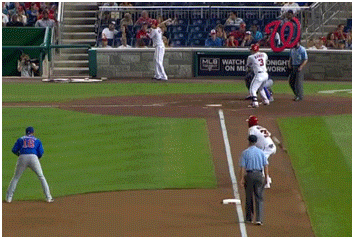|
By: Bob McCreary - Baseball by the Yard At the college and professional levels, you don't see many squeeze plays. However, I have noticed more of them on MLB highlight shows so maybe it's returning to fashion. Tampa Bay Rays manager Joe Madden recently put on two squeeze plays on back-to-back batters! I love it! I have found the squeeze play to be very successful most of the time. In this two part post I'll first talk about the "why" and "when" of the suicide squeeze. The remaining parts will deal with the "how's" and offer tips for the batter, the runner, the 3rd base coach, the guys on the bench, and the defense.
- It's a risky play but time it right and there is no way to defend against it. Why Squeeze? The main reason why I like the suicide squeeze is because if done correctly, aside from guessing right on a pitch-out, there really is no defending it. Basically, all the batter has to do is put a halfway decent bunt on the ground and you have a run. Obviously, there are a lot of little things that have to go right for it to work but most of those things are under your team's control. Deciding when to squeeze, giving and receiving the sign, the timing of when the runner breaks and the batter squares to bunt, the hitter's bunting mechanics, and the conduct of the bench are all examples of the variables that are under a team's control. The only two variables that are not under the offensive team's control is what pitch is thrown and where it ends up. If a coach picks the right time to put the play on, even those problems becomes less of an issue. When To Suicide Squeeze? As a coach, the first thing to understand is that other than putting it on with two outs, there really should be no rules etched in stone as to when notto squeeze. It can be successfully done in virtually any situation with any batter. As I stated earlier, if all participants do their job at the right time, there really is no defending it. That being said, there are times when the odds are even more in your favor due to the situation. On the other hand, letting certain batters swing away can be better suited for situations as well. A lot of this comes down to the manager's offensive philosophy and how bad his team needs that run to score. Below are some variables that a coach or manager can factor in when trying to determine whether the situation is ripe for a squeeze play:
I am a big fan of the suicide squeeze. Deciding when to put it on involves a number of variables and always will involve an element of risk. However, I believe the rewards of including a squeeze play into your offensive strategy is well worth the risk. The Suicide Squeeze - Part 2: Giving & receiving the sign In Part 2 of the suicide squeeze, I begin to present many of the "how's" so that players and coaches can execute the play more successfully. Initially, I had planned on a two part post on the squeeze play but to be completely thorough I decided to divide it up into several separate posts. Today, it involves tips for giving and receiving the sign. Tips for Giving The Squeeze Sign:
- Be careful not to develop a "tell" when giving signs to players. Give The Sign Frequently. The third base coach should get into the habit of giving the sign for the suicide squeeze a few times throughout the game when there is not a runner at 3rd base. Of course, hitters and runners should be told beforehand that when this occurs, no play is on. It only is in effect when there is a runner at third base. Doing this insures that anyone trying to steal your signs will have a tougher time. Let's say your squeeze sign involves touching an elbow. If the only time you touch your elbow is in a possible squeeze situation, the "sign stealer" is going to notice that you just gave a unique sign you haven't given before. He may know something is up and call for a pitch-out. If you give the sign frequently during the game in non-squeeze situations, you will not be doing anything new or unique on the actual squeeze play. Be Careful of Body Language. Good sign stealers don't just look at what signs are given by the third base coach. They also look for patterns in body language of the coach giving the signs. For example, a coach might develop the habit of standing still while giving signs when nothing is on. However, when a play is on (steal, bunt, squeeze, etc), he may unknowingly take a couple steps towards the batter or runner before giving the sign as if to say "I want to make sure he sees this sign." Without realizing it, he just tipped off that something may be on. In card playing, this is called a "tell." A player unintentionally develops a habit - an eye or hand movement, etc. - that tips off when they are bluffing or have a good hand. Coaches sometimes do the same thing. This type of thing can also occur in situations when the third base coach receives the signs from the manager in the dugout who then passes them on to the batter. The third base coach may act very relaxed when the manager flashes a set of signs when nothing is on but all of a sudden stiffen up or focus on the manager a bit more when he sees the squeeze sign coming from the dugout. There are many variations of this. The point is to do your best not to develop any unusual habits during the process of giving the sign to the batter. Tips for Receiving The Sign. Be Careful of Body Language. What you just read about coaches tipping off the squeeze sign applies to batters as well. A batter should never alter his routine during and/or after they get the squeeze sign. Any variation to their normal pre at-bat routine signals that something different might be about to happen. Some common mistakes hitters make are:
The Return Sign On many teams, it is a common procedure to let the third base coach and runner know that you (the hitter) have received the sign for the squeeze play. After getting the sign, the hitter is required to give some kind of signal back to the coach and runner. It could be touching the bill of his helmet, taking a practice swing, stepping into the box with his right foot first, or anything else that the team decides. The reason for this is that nobody wants to be sprinting down the line towards home only to have the hitter swing away and possibly hit a ball down the third base line. You can imagine the danger in that.
- This scare probably took at least 3 years off the runner's life. If the hitter does not respond with the return sign, the coach can call timeout before the pitch to avoid this danger. If a coach does require a return sign, care should be taken to choose something that batters commonly do so that the other teams' spies don't notice it. It is important to note that any return signal given by the hitter increases the likelihood that the defense will be tipped off on the squeeze. Because of this, some teams do not require a return sign. In that case, it just becomes the very important responsibility of the batter to NOT miss the squeeze sign. Each coach should weigh the pros and cons and develop a policy they are comfortable with. About the Author... I am proud to come from a baseball family. My grandfather's (Mother's side) name was Hal Kelleher. He pitched for the Philadelphia Phillies in the 1930's. My father was a long time baseball coach at the youth, high school, and college levels. He even had a chance to coach in the College World Series while an assistant at Temple University in 1972. While in the military service, my father was stationed at Fort McPherson outside of Atlanta, Georgia which had a general that was a baseball fanatic. He did everything he could to bring major league players who were drafted into the Army to Fort McPherson. As a result, Fort McPherson was stacked and won the All-Army Championship as a result. My father played second base on that team. Being around those major leaguers was quite a learning experience for my Dad. He learned about the mental toughness of major leaguers and all the finer points that made them tremendous players. Because of all this, from the time I picked up a baseball, I was learning the finer points of the game. Many of the things I was learning at a young age are not generally taught to players until they get into the higher levels. I was very fortunate to have those good baseball people close to me. When I finished my playing career, I decided I wanted to pass on these finer points to as many players, coaches, and parents as I could. My coaching, this website, and especially my blog are all an attempt to do that. I hope you enjoy what I have to offer. If you are a player or coach, I hope that something you learn from me gives you a better chance at playing and/or coaching at the levels I have been fortunate to experience. Best of luck to all of you on your baseball journey! Bob McCreary |









